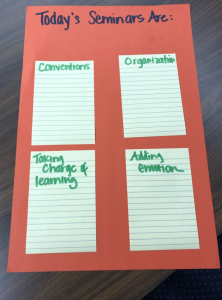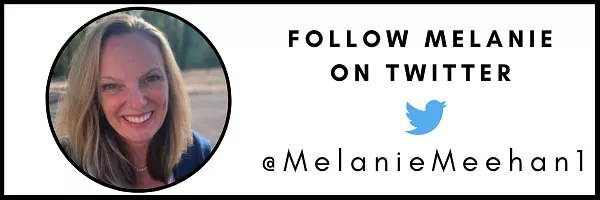TL;DR:
- Assessment doesn’t always have a positive connotation.
- Start with an asset-based mindset: what can students do well?
- Clarify what you want the students to be able to do and look for it.
- Involve students in the goal-setting process.
Sneaking Assessment Into Writing Instruction
If I mention assessment to teachers, they cringe. Maybe the cringe comes from the thought that assessment is done to students as opposed to for students. In addition, assessments take a long time. Whatever the reason, I work to shift the thinking so that teachers understand and celebrate the benefits of meaningful assessment. It’s a pillar for high-impact instruction and learning.
Lead With an Asset-Based Mindset
An asset-based mindset involves beginning any type of evaluative conversation or process from a standpoint of what people can do, as opposed to what they can’t. What is right, as opposed to what is wrong? When we talk about students, many of the teachers I work with know that my first question will center on what students can do. When we look at student writing, my first read is focused on what skills and abilities are shining through. Oftentimes, we work on a chart along these lines:

When we begin with what students are doing well, positive things happen! Teachers shift into a more celebratory mindset during the meeting, and that mindset has the power to carry over into their work with students. When students receive feedback about what they are doing well, they are more apt to continue doing those things.
When we begin with what students are doing well, positive things happen! Teachers shift into a more celebratory mindset during the meeting, and that mindset has the power to carry over into their work with students. Share on XEstablish Clarity of What to Look For
Another critical element of assessment involves knowing what you’re looking for. What is it that you really want students to know and be able to do? What does that look like? How do you know?
Sometimes we list out skills together and even sort the skills. There are some skills that fall into the category of writing behaviors, such as initiating their work, staying on task, and producing an established amount of writing. Other skills may fall into the realm of conventions, grammar, or spelling, as opposed to content and ideas.
A useful tool to create for a writing unit is a Learning Targets Collection Sheet. Here is a sample of one I’ve created for a third-grade information writing unit. You can list students down the left side of the table and skills across the top. Then, throughout your instruction, you can be on the hunt for evidence of approximation and mastery of the specific skills you are teaching and prioritizing.
Expand the Opportunities for Assessment
Sometimes, it’s easy to fall into the trap of thinking that assessment only happens when you’re “giving a test” or when students are writing their final pieces. However, assessment can happen throughout every day—even every minute!
- Are students listening and understanding your instruction? Ask them to explain what you’ve taught in their own words…that’s assessment!
- Do students have meaningful conversations with each other, asking and responding to questions about their work in progress? Listen in to the interaction…that’s assessment!
- How do students begin and sustain their writing? Study their behaviors as they are working…that’s assessment!
There are opportunities to study not only the work but also the behaviors and understandings of the work. The more teachers understand the underlying student processes behind the written work they produce, the better teachers can tailor and differentiate instruction.
Involve Students in Setting Goals
John Hattie is an educational researcher who has conducted meta-analysis studies that looked at factors related to student achievement. Across all of his studies, self-reported grades and self-assessment emerges as a top indicator of student achievement. Leaning into this finding, what are some ways to involve students in their own learning, knowing and understanding what they are learning and how they know they are doing a good job?

One of my favorite ways is to use surveys that ask students about how they see their work. I’ve created Goals for the Week Google Forms, and these forms help plan and determine conferences and small groups. Even when I don’t agree with students about how they fill out these forms—many students are harder on themselves than I would be—these forms help me know what students understand about themselves as learners. The more I invite students to self-assess and set goals for themselves, the more accurate and reliable the self-reporting becomes!
In addition to Google Forms, I also encourage students to sign up for small groups that I refer to as seminars. By using large sticky-notes, I can easily swap out seminars for the day and keep track of who has signed up for what.
My sticky-notes become a trail of instruction—a way for me to keep records, analyzing the effectiveness of instruction.
[scroll down to keep reading]
Sneaking Assessment Into Writing Instruction: Final Thoughts
The word assessment has its Latin roots from assidere which means to sit beside. I love to think about assessment in terms of what I can learn about students when I sit down next to them. Who are they as a writer? What can they do? How do they talk about their work? What do they see as the next steps? “Basically, you are assessing student writers every single minute!” a teacher once said to me. “I guess I am,” I answered, “but only because it helps me know my next steps as a teacher and their next steps as writers.”
About Melanie Meehan
Melanie Meehan has been the Elementary Writing and Social Studies Coordinator in Simsbury, Connecticut since 2012. Melanie wrote Every Child Can Write, published by Corwin Press in October 2019, and, The Responsive Writing Teacher, co-written with Kelsey Sorum, published in March 2021. Her most recent book. Teaching Elementary Writing is part of the Five to Thrive series from Corwin Press. She is a co-author of Two Writing Teachers, and you can connect with Melanie on Twitter @melaniemeehan1.


